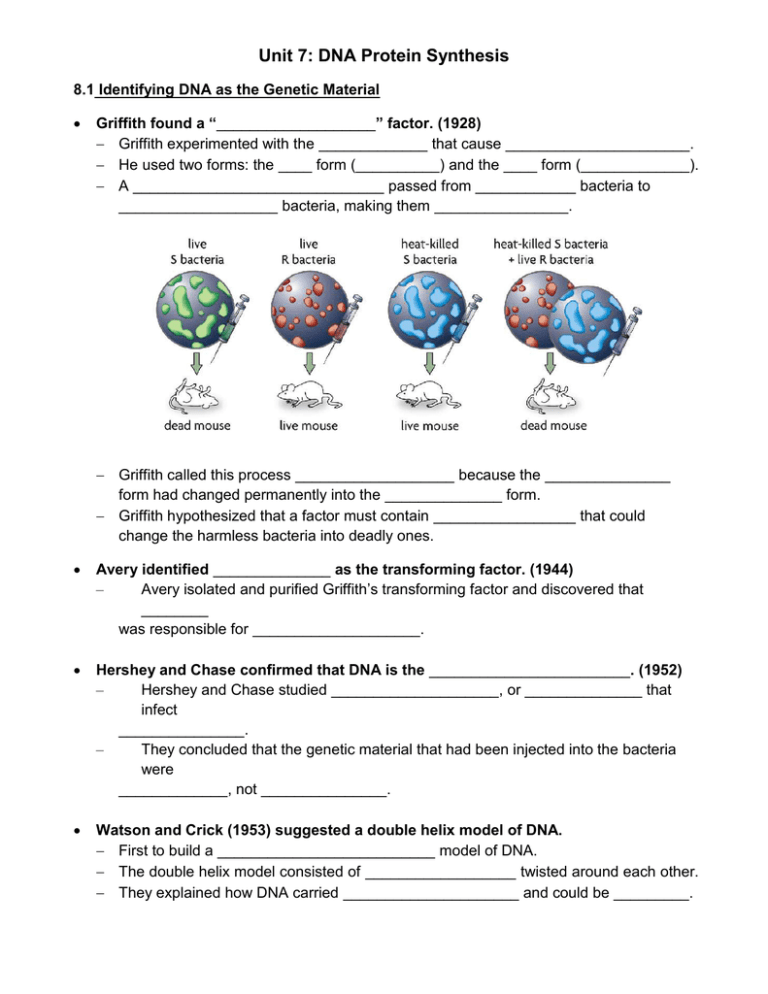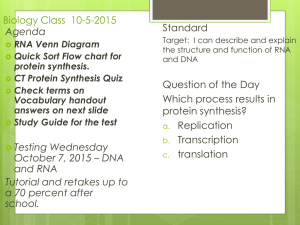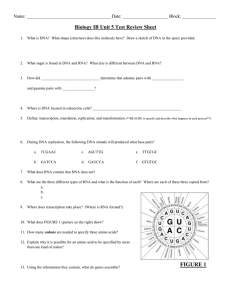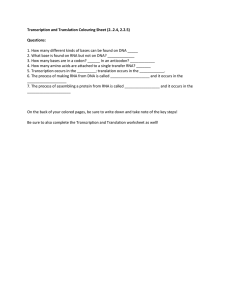Unit 4: DNA Protein Synthesis
advertisement

Unit 7: DNA Protein Synthesis 8.1 Identifying DNA as the Genetic Material Griffith found a “___________________” factor. (1928) Griffith experimented with the _____________ that cause ______________________. He used two forms: the ____ form (__________) and the ____ form (_____________). A ______________________________ passed from ____________ bacteria to ___________________ bacteria, making them ________________. Griffith called this process ___________________ because the _______________ form had changed permanently into the ______________ form. Griffith hypothesized that a factor must contain _________________ that could change the harmless bacteria into deadly ones. Avery identified ______________ as the transforming factor. (1944) – Avery isolated and purified Griffith’s transforming factor and discovered that ________ was responsible for ____________________. Hershey and Chase confirmed that DNA is the ________________________. (1952) – Hershey and Chase studied ____________________, or ______________ that infect _______________. – They concluded that the genetic material that had been injected into the bacteria were _____________, not _______________. Watson and Crick (1953) suggested a double helix model of DNA. First to build a __________________________ model of DNA. The double helix model consisted of __________________ twisted around each other. They explained how DNA carried _____________________ and could be _________. 8.2 Structure of DNA DNA is composed of ____________ types of nucleotides. DNA is made up of a long chain of __________________. Each nucleotide has ___________ parts. a __________________ group a ________________________ a _____________________________ Label the following nucleotide: The _________________________ are the only difference in the four nucleotides. Label the following nitrogen bases: Watson and Crick’s discovery built on the work of Rosalind Franklin (1952). - Used _____________________ to determine the shape of the DNA molecule. The X-ray images suggested that DNA was a ____________________ of even width. Nucleotides always pair in the same way. ________________ (1949) discovered the __________________________ for nitrogen base: _____ pairs with _____ _____ pairs with _____ Because a ___________________ (__________ ring) pairs with a ____________ (____________ ring), the helix has a uniform width. The _______________________ backbone is on the _____________ and connected by ___________________ bonds. The ________________ are on the ____________ and connected by __________________ bonds. Label the types of bonds that form this DNA molecule: 8.3 DNA Replication Central dogma of biology shows the flow of genetic information from ___________ to ____________ to __________________. Replication _____________ the genetic information. The two strands of DNA serve as ________________ to make __________________ of itself using the __________________ rules. DNA is replicated during the ____________________ stage of the cell cycle. Steps of DNA replication 1) Enzyme ______________________ unwinds and unzips the double helix. 2) ______________________ between the double helix break and two strands ______________. 3) DNA polymerase bond the free-floating _________________ with the template strand using the base-pairing rules (___________________) Label the following model of DNA replication: 4) Two new molecules of DNA are formed, each with an _____________________ (parent strand) and a ________________________ (daughter strand). 8.4 Transcription RNA carries DNA’s instructions. – The central dogma states that information flows in one direction from ___________ to ______________ to ___________________ through three process: Replication Transcription Translation – ________________ is a link between DNA and proteins. From DNA to protein Structure of RNA _________________________ ____________ strand Made up of ______________ types of nucleotides. Each nucleotide has three parts: a _________________ group a ______________ sugar a __________________________ (4 types) Label the following RNA nucleotides: The four nitrogen bases in RNA are: adenine (A) guanine (G) cytosine (C) uracil (U) ________________ of RNA replaces ________________ of DNA Types of RNA 1) ________________ (messenger RNA): - carries _____________ of instructions for assembling ______________ into ________________. 2) _________________ (transfer RNA): - transfers __________________ to ________________ to make proteins 3) ________________ (ribosomal RNA): - makes up ___________________ Comparing DNA and RNA RNA • contain ______________ • contain ______________ • ____________strand • ____ types (___________________) • carry ________________ DNA • contain _________________ • contain _________________ • _____________ strands • ___ type • carry ____________________ Transcription makes __________ from _____________. RNA copies the ___________________ inside the _____________ because DNA _____________________________. replication transcription Steps of transcription 1) __________________________ binds to DNA and _____________ a segment of it. 2) RNA polymerase uses one strand of DNA as a _____________ from which ____________________ are added using the base-pairing rule (_______________) 3) DNA ______________ again as the gene is transcribed. 4) The RNA strand ________________ from the DNA once the gene is transcribed and travels to _________________ for __________________________. RNA Editing – The DNA of eukaryotic genes contains both introns = _____________ regions exons = _____________ regions – When RNA molecules are formed during transcription, both _________ and _________ are copied from DNA. – The introns are _____________ of RNA molecules. – The exons are the __________________ to form the final mRNA. The transcription process is similar to replication. Transcription and replication both involve _____________________ and _______________________ base pairing. The two processes have different end results. Replication copies ______________ the DNA; transcription copies ____________. Replication makes __________ copy; transcription can make ___________ copies. 8.5 Translation _______________________ are coded by mRNA base sequences. _________________ converts _______________ on mRNA into _____________ at the _________________. Each protein is made up of __________________. Each ______________ codes for an amino acid. mRNA is translated in _____________________ called ______________. A codon is a sequence of ______________ nucleotides that codes for an ____________________. There are _________ essential amino acids that need to be synthesized. The ______________________ can be used to determine which ___________ represents which ___________________. Some amino acids are coded by _________________________. Why do codons have to be 3 letters long? If codons are only ___ letters, then the total possible codon combinations would be ___ x ___ = _ ___ If codons are ___ letters, then the total possible codon combinations would be ___ x ___ x _____ = _ ___ There are _____ codons for _____ amino acids. Most amino acids are represented by _________________ codon. There is ______ START codon, __________, that codes for Methionine (_______). There are ___________ STOP codons: ______________________________ tRNA transfers _________________ from ________________ to ________________. tRNA contains _________________. An anticodon is a set of ___________ nucleotides that base-pair with an ___________________ at the ribosome. (_________, ___________) Each tRNA carries ______________________ of amino acid. Label the tRNA molecule below: Ribosomes consist of _____________________. The _________________ subunit has three binding sites for ______________. The _____________ subunit binds to _______________. Label the ribosome: Steps of Translation 1) mRNA leaves the _________________ and travels to the _____________________. 2) The start codon, _____________, begins the translation process. 3) tRNA carries its specific ___________________ to the ribosome and its ________________ base pairs with the __________________. 4) The _____________ releases its amino acid to the amino acid of the next tRNA and _______________. 5) ______________________ binds the amino acids together by __________________. 6) tRNA continue moving down mRNA and transferring amino acids until it reaches a ___________________.






